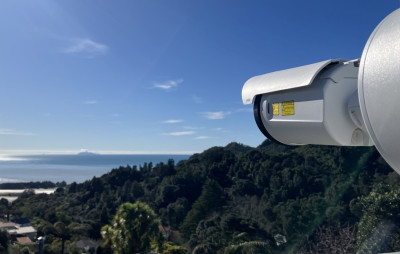Procuring web cameras for the most extreme environments
Recently procured web cams are integral to the critical service Earth Sciences NZ provides, keeping New Zealanders safe from our natural hazards.

The new Q1808-LE bullet camera installed at Whakatane, looking out towards Whakaari/White Island. Photo: Earth Sciences New Zealand.
Earth Sciences New Zealand has a network of web cameras operating around the motu, continuously streaming images to our 24/7 National Geohazards Monitoring Centre.
The web cams are integral to the critical service Earth Sciences NZ provides, keeping New Zealanders safe from our natural hazards. The images are reviewed by Geohazard Analysts and Volcano Specialists, who identify signs of eruption or surface changes. This analysis underpins rapid response efforts and public safety advisories.
Earth Sciences NZ has just finished a project to procure equipment in support of volcano monitoring.
Needing to operate around the clock in some of our harshest environments, the procurement team had to identify web cameras that would be able to withstand extreme conditions and provide effective hazard monitoring.
Procurement Manager Peter Royle led the procurement side of the infrastructure work and highlights a range of factors guiding the procurement process.
"The best part of this project was getting to work with great people.
“Our science teams are innovators who challenge boundaries. They are passionate about protecting the public."
Earth Sciences NZ needed 13 network camera units with visual and or infra-red imagery capabilities – and the assurance that a secure supply of accessories and services would support ongoing work.
Peter's team put out a 4-week tender last year on GETS to find a supplier for the remote volcanic sensing network.
After short-listing from the commercial evaluation, the tech team tested a range of cameras in the field and streamed the data to assess the quality in a range of environments. The testing programme considered the quality of the data produced, the simplicity of installing and maintaining the site, and the technology used.
The results informed the business which cameras performed best and what supplier/brand of camera would best support the business in the long-term.
“We were really happy to go with a local supplier”, Peter said
When setting up a procurement project, Peter recommended procurers worked to make sure projects had a good base aligned with the workplace's business strategy. He recommended early engagement with stakeholders.
"This ensures project criteria matches expected outcomes," he explains.
This investment supports GeoNet’s broader outcome of delivering security to New Zealanders.
“Not only have they delivered advanced imaging technology, we also have access to equipment with enhanced night-time image quality. This significantly benefits our operational needs while ensuring greater security for New Zealanders.”
“Investing in technology enables us to maintain research capability along with geohazard monitoring for response purposes," Peter said.
Interesting facts about the web cameras:
- Earth Sciences New Zealand has 10 web camera stations across mainland New Zealand and offshore volcanoes.
- The web camera monitoring network has been operational since 2001.
- The network is essential for volcanic activity assessments and eruption detection, as well as internal research applications.
For more information about the monitoring programme: